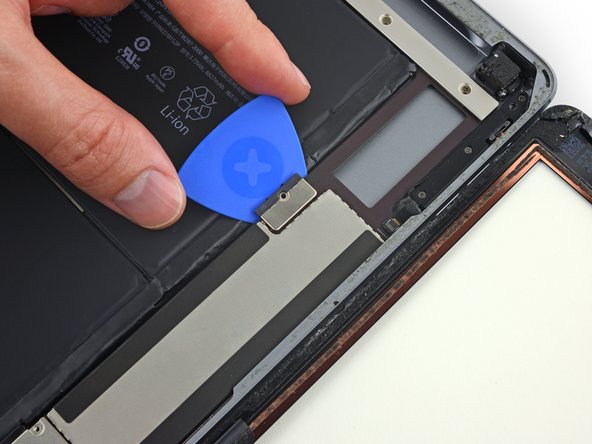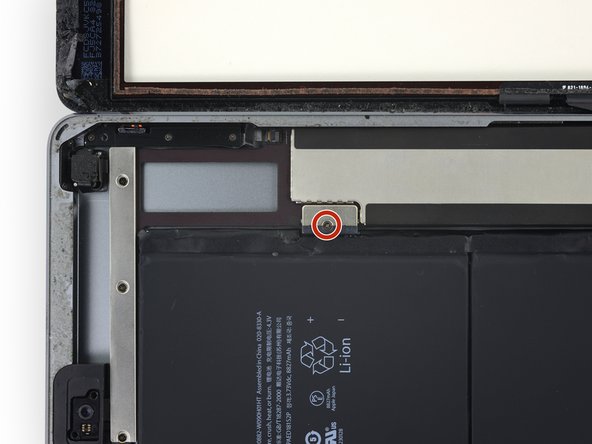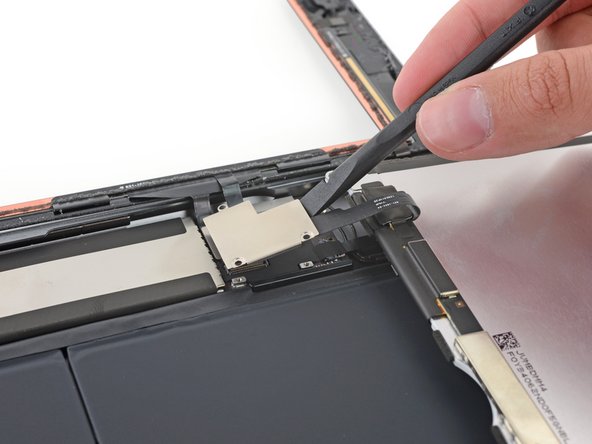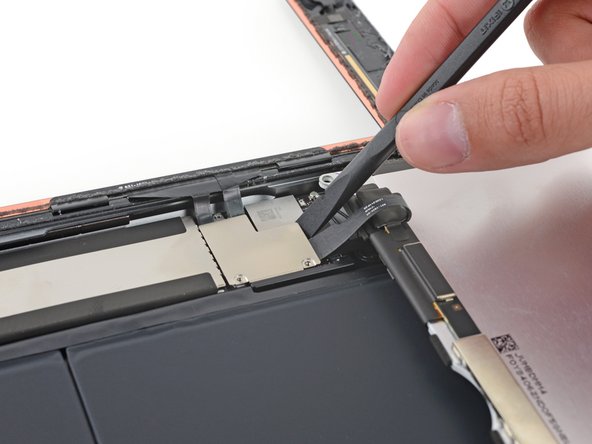iPad 6 Wi-Fi Front Panel Assembly Replacement
Duration: 45 minutes
Steps: 46 Steps
Heads up! The Touch ID sensor in the Home button is best friends with the logic board. To keep your Touch ID working like a charm, make sure to move the original Home button over to the new front panel assembly.
Take it slow and steady when you’re isolating the battery using a battery blocker—no one likes surprises!
Hey, let's dive into replacing the front glass and digitizer on your iPad 6. Keep in mind, the Touch ID sensor in the Home button is linked to the logic board, so transfer the original Home button to the new front panel to keep Touch ID humming. Handle the battery isolation with a blocker super gently—these contacts dent easily, leading to permanent trouble. If you're bypassing isolation, skip metal tools unless you're dealing with screws to dodge shorting the battery and zapping those delicate circuits.
Step 1
- Warm up your iOpener and press it against the left edge of your device for about two minutes. Give it a little time to work its magic before moving on.
Tools Used
Step 2
- While you're letting the adhesive take its sweet time to loosen, keep an eye on these sensitive spots that need some extra love when prying:
- Front camera
- Antennas
- Display cables
Step 3
The next three steps show off our Anti-Clamp tool, which makes opening things up way smoother. If you're not using it, feel free to skip ahead three steps for another approach.
For full instructions on using the Anti-Clamp, check out this guide.
If the iPad's surface feels too slippery for the Anti-Clamp to get a good hold, just add some tape to give it more grip.
- Give the blue handle a little pull to free the Anti-Clamp's arms.
- Place something underneath your iPad to keep it steady and level between the suction cups.
- Set the suction cups near the middle of the left edge—one at the top and one at the bottom.
- Hold the bottom of the Anti-Clamp in place, then gently press down on the top cup to create suction.
Step 4
- Gently pull the blue handle forward to lock those arms in place.
- Turn the handle clockwise a full 360 degrees, or keep going until the cups start to stretch a bit.
- Keep those suction cups aligned with each other. If they start to slip out of line, just loosen them a tad and realign the arms.
Step 5
Take it slow – no more than a half turn at a time, and give it a minute between each twist. Let the Anti-Clamp and a little patience do their thing.
Looking for the best way to use a hair dryer? Check out this guide for all the details you need.
If the Anti-Clamp isn't making enough space, just give it a little more heat and twist the handle clockwise for about half a turn.
- Hang tight for a minute—let that adhesive loosen up and create that sweet opening gap.
- If the screen's playing hard to get with heat, grab your hair dryer and blast along the left edge of your iPad.
- Slide that opening pick under the digitizer once the Anti-Clamp gives you a decent gap to work with.
- Feel free to jump over the next one.
Step 6
If your display is totally shattered, try slapping on some clear packing tape to help that suction cup stick like a champ. Not working? Swap in some seriously strong tape instead. Still no dice? Give supergluing the suction cup to the screen a whirl. If you need help, you can always schedule a repair.
- When the screen feels nice and warm to the touch, grab your suction handle and stick it onto the left edge of the screen, right up close to the border.
- Gently lift the screen with that suction handle to open up a tiny gap between the digitizer and the frame—easy does it!
- Slide an opening pick into that gap you just created between the digitizer and the frame.
Tools Used
Step 7
No need to stress if you spot the opening pick peeking through the digitizer — just pull it out. The LCD screen should be safe, but you might leave behind some sticky adhesive that’s a pain to clean up.
- Toss in a second opening pick into that gap you just created.
- Glide it toward the bottom-left corner to loosen the adhesive.
- Leave it parked in the bottom-left corner to stop the adhesive from resealing.
Step 8
- If the opening pick gets stuck in the adhesive, just give it a gentle 'roll' along the side of the iPad to keep peeling away that stubborn adhesive.
Step 9
- Gently slide that first opening pick toward the top-left corner of the device to break free from the adhesive.
- Keep the pick hanging out in the top-left corner to stop the adhesive from sticking back together.
Step 10
- Warm up your iOpener and gently apply it to the top edge of the device for about two minutes.
Tools Used
Step 11
- Gently work the pick around the top-left corner of the device to break through the adhesive. Take it slow, and you’ll have it free in no time!
Step 12
Hey, steer clear of sliding that pick over the front camera—you might scratch the lens! The next steps will show you how to avoid that hiccup.
- Gently slide the opening pick along the top edge of the device, making sure to stop just before you get to the front camera. Take it slow and steady – you're almost there!
Step 13
- Gently pull the pick out until just the tip is hanging out between the digitizer and the frame.
- Carefully slide the pick over the top of the front camera to loosen the adhesive.
- Keep the pick resting near the right side of the front camera before moving on.
Step 14
- Pop the pick back in and glide it toward the top-right corner of the device to fully separate the top adhesive.
- Leave the pick in the top-right corner to keep the adhesive from re-sealing.
Step 15
- Warm up your iOpener and give it a two-minute session on the right edge of your device. It’s like a little spa treatment for your tech—let it soak up the warmth before moving on.
Tools Used
Step 16
- Gently work the pick around the top-right corner of your device to break the adhesive seal. Take it slow and steady!
Step 17
Hey, the display cables are chilling about halfway up from the bottom of the iPad. Ease up and stop sliding once you're three inches from the bottom edge.
- Grab your trusty opening pick and slide it smoothly towards the middle of the iPad’s right edge. You got this!
Step 18
- Get your iOpener heated up nicely and gently press it onto the bottom edge of the device for two minutes to get things loosening up.
Tools Used
Step 19
Take it easy—don't spin the pick fully around the corner, or you might hurt the antenna.
- Slide that bottom-left pick toward the bottom-left corner to loosen up the adhesive.
- Keep the pick hanging out in the bottom-left corner before jumping to the next move.
Step 20
Keep that pick sliding straight towards the home button—no going the other way, or you might ding the antenna!
If you need to move the pick over this spot again, just pop it out and slide it back in at the bottom-left corner. Easy peasy!
- Slip a fresh opening pick into that gap you just opened up on the bottom edge of the iPad.
- Gently slide the pick over the antenna, stopping right before the home button.
- Park the pick to the left of the home button before you keep going.
Step 21
Be careful! Insert the pick no more than 1 mm to avoid any damage to that delicate antenna on the right.
- Gently slip that opening pick into the gap you just created.
- Now slide the pick under the home button, aiming for the bottom-right corner—keep just the tip between the digitizer and the frame to stay safe.
Step 22
Slide the pick gently towards the home button, not away from it—trust us, you don't want to mess with the antenna!
If you gotta slide that pick over this bit again, just pull it out and stick it back in at the bottom-right corner.
- Insert the pick again, then gently slide it towards the home button to completely break free the bottom adhesive.
- Leave the pick right next to the home button before moving on to the next step.
Step 23
- Warm up an iOpener and gently press it to the right edge of your device for about two minutes. Give it a moment to work its magic!
Tools Used
Step 24
Take your time with this step – patience is key! Make sure the adhesive is nice and soft, and give yourself the chance to carefully work through it with a pick. If you're not getting anywhere, don’t hesitate to stop and reheat. No rush, we’ve got this!
If you're feeling some serious resistance, don't worry – just reheat those edges a bit and gently work your way around with an opening pick. Take it slow, and it'll come apart!
- Give those opening picks a little twist on the left corners of the iPad to lift the digitizer just a bit, peeling away the last of that stubborn adhesive.
Step 25
- Gently lift the left edge of the digitizer upward to peel back more of the adhesive along the right side of the iPad.
Step 26
- Carefully hold the digitizer in place and gently slide an opening pick between the display cables to free up that last bit of stubborn adhesive. Almost there!
Step 27
- Once the adhesive is all separated, gently open the digitizer like a book and lay it flat next to the iPad, keeping it nice and parallel.
- When putting everything back together, grab some isopropyl alcohol and clean off any leftover adhesive from the frame—and from the digitizer if you’re reusing it. Then, slap on some fresh adhesive strips or pre-cut adhesive cards to get everything stuck down securely.
- Watch out for the display cables when you’re reassembling! Make sure they’re tucked neatly under the LCD screen to avoid any potential damage. A little care now can save you a headache later!
Step 28
- Peel off any tape that's covering the LCD screws.
Step 29
- Grab your Phillips #00 screwdriver and unscrew those four 4.3 mm screws holding the LCD—piece of cake!
Step 30
Hey, don't try to yank the LCD out all the way—it's still hooked up by some cables at the home button end. Just lift it from the front camera side.
Take it nice and easy, and keep an eye on those LCD cables while you flip the display over.
Carefully place the LCD screen on a soft, clean, lint-free spot to keep it safe and sound.
- Gently use the flat end of a spudger to nudge the LCD out of its spot just enough so you can grab it with your fingers. Watch out—there might be some glue hanging around the screw holes that you'll need to carefully slice through with a knife.
- Flip the iPad LCD over like turning a page in a book, lifting near the camera and folding it back over the home button end of the rear case.
- Set the LCD face down so you can easily reach the display cables.
Tools Used
Step 31
Hey, these pics give you a peek at the battery connector tucked under the logic board. Use 'em as your guide to safely disconnect the battery.
Spot those cantilever springs on the logic board? They press against the battery contact pads. Since the board and battery are glued down, gently slide something thin and flexible between the contacts to disconnect the battery.
Step 32
To dodge any short-circuit drama, grab a battery isolation pick to safely disconnect the battery.
Don't jam that battery blocker under the connector too hard. If it's giving you grief sliding under the logic board, swap in a trusty playing card to handle the battery disconnection.
Ideally, the battery blocker or playing card should glide smoothly under the logic board without any hiccups. Once in, let it chill at a cool 15-degree angle.
- Carefully unscrew that single 2.3 mm Phillips #000 screw holding the battery connector to the logic board.
- Slide the battery blocker smoothly underneath the logic board's battery connector at a 35-degree angle.
- Keep that battery blocker right in place while you handle the next steps.
Tools Used
Step 33
- Alright, let's pop out those three 1.4 mm Phillips #000 screws from the display cable bracket!
Step 34
Heads up! The display cable connector is stuck to the bottom of the bracket, so don’t go shoving the spudger too deep under there or you might accidentally mess up the connector.
- Grab the flat end of your spudger and give the display cable bracket a gentle, straight-up pry from the logic board.
Tools Used
Step 35
- Gently detach the LCD from the device.
Step 36
- Peek under that home button ribbon cable connector and gently peel away any tape keeping it covered – time to set it free!
Step 37
- Grab the flat end of your spudger and give that tab on the home button ribbon cable ZIF connector a gentle upward flip.
- Carefully slide the home button ribbon cable straight out of the ZIF connector.
Tools Used
Step 38
Be gentle when prying, and stick to the connectors—don't mess with the socket on the logic board. We want your iPad in one piece, not in pieces!
- Grab the flat end of a spudger or your fingernail to gently lift the two digitizer cable connectors straight out of their sockets.
- When putting it back together, double-check that these connectors are fully seated, or you might run into display issues.
Tools Used
Step 39
- Gently lift the home button ribbon cable off the gooey adhesive stuck to the rear case.
Step 40
The insulation is tucked away out of sight, unlike the foam dust barrier strips you usually see on iPads.
- Start by carefully removing the front panel assembly.
- If you’re facing ‘ghost’ or ‘phantom’ touch issues with your new display, no worries! Just add a thin layer of insulating tape (like Kapton tape) to the highlighted areas on the back of the panel. Most panels come pre-insulated, so this might not be necessary, but it’s a good fix just in case.
- Without the proper insulation, certain parts of the digitizer might end up touching other components, which could mess with your touch input. Make sure it’s all properly insulated to keep things running smoothly!
Step 41
- Start by carefully lifting the home button cable off the back of the front panel, take it slow and steady.
- Keep peeling the cable back until you hit the metal shield—just a little more patience, you're almost there!
Step 42
- Slide an opening pick between the metal shield and the front panel, then gently wiggle it free from the digitizer—easy does it!
Step 43
- Carefully lift the metal contact away from the home button bracket without rushing—it’s a delicate little guy!
Step 44
- Grab your plastic opening tool and gently pry the home button bracket off the back of the front panel – take it easy!
- Once you've got one side separated, firmly grab the bracket and peel it off the front panel like it's a tough sticker.
- When reattaching, add a dab of adhesive or double-sided tape to secure the bracket in place.
Step 45
Ease on the pressure gently; the adhesive is bonded to a fragile gasket that tears easily.
- Give the home button a friendly press from the outside of the digitizer to loosen up that sticky adhesive.
Step 46
- Alright, time to put it all back together! Just follow these steps in reverse order. If you need a hand, you can always schedule a repair.



















































































































